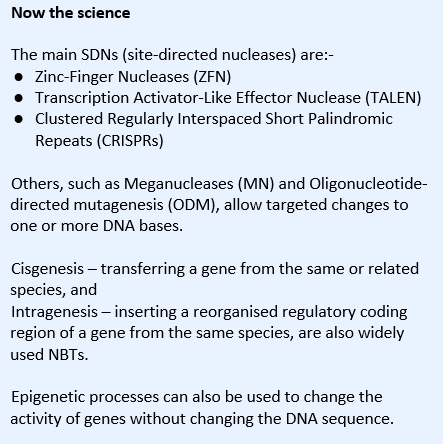A regulatory system that is as clear as mud to many crop producers and the United Kingdom’s withdrawal from the European Union will raise new questions, says James Fitzgerald.
A middle ground has opened up in the world of plant breeding, where new cultivation techniques offer alternatives to both conventional and transgenic methods known as GMOs, or genetically modified organisms. It might sound innocuous, but the outcome of the current regulatory debate on the issue has the potential to completely reshape the landscape of our food.
The UK’s Parliamentary Office of Science and Technology is seeking to clarify its position on these new breeding techniques (NBTs). The big regulatory question is, should these methods be classified as genetic modification or not?
The term “genome editing” applies to a suite of site-directed nucleases (SDN) capable of cutting or otherwise modifying predetermined DNA sequences in the genome. The aim is to introduce new or modify existing traits efficiently in key crops. Some of these crops are difficult to distinguish from conventionally bred plants.
Some plant breeders and the biotech industry fear that regulatory uncertainty over these techniques may hinder innovation and make business planning difficult for practical applications of gene editing.
Many NGOs remain concerned about the patentable nature of crop modification, leading to control of the food production chain by a small number of multinational agrochemical groups.
“If genome-edited organisms are classified as GMOs it will restrict use of the technology to multinational biotech companies working on profitable traits in the main commodity crops,” says Huw Jones, professor of translational genomics at Aberystwyth University. “However, for gene-edited plants with no foreign DNA, a regulatory framework that is proportionate to the risks will allow smaller plant breeders and research organisations to use these benign methods for public good breeding projects in locally important crops.”
Writing in the Biochemical Society journal in June 2016 Prof Jones also proposes a proportionate regulatory framework using existing novel food laws or varietal registration processes.
A group of non-government organisations (NGOs), including TestBiotech, Greenpeace and Friends of the Earth, published an open letter to the European Commission (EC) in 2015 urging it to ensure “that organisms produced by these new techniques will be regulated as genetically modified organisms under existing EU (European Union) regulations (Directive 2001/18)”.
These strongly held and opposing views may have delayed the EC’s deliberations on what constitutes a GMO. In March last year, an EC spokesperson said: “we are currently working on a legal analysis to give guidance on how to interpret the definition of GMOs in relation to organisms produced by new plant-breeding techniques”.
The Soil Association has dug its heels in. Peter Melchett, its policy director, says: “GM is defined under EU law as covering any modern breeding technique that directly modifies genomes. The international Cartagena Protocol uses similar language. Gene editing or splicing is GM technology, and should not be adopted as a practice in Europe. Editing the genome of a plant always has the potential to disrupt the DNA. As with other genetic engineering, gene-editing can cause unintended changes in genetic material, with some techniques causing editing (cuts and alterations) in DNA in places in addition to the intended location. As a Greenpeace policy briefing on this says: ‘the newly created organisms can still display unexpected and unpredictable effects, which can have implications for their food, feed or environmental safety’.
“There are no advantages to editing DNA that outweigh the risks caused by the inherent uncertainties in this technology. Almost all claimed advantages are already being delivered by more modern, faster and less risky crop-breeding technologies, such as marker-assisted selection.”
However, current plant varieties may be unsuited to changing environmental conditions – particularly in the midst of global warming. The spike in wheat prices after drought decimated the Russian harvest in 2010 is one geopolitical event cited by biotech scientists, but whether genome editing could really make plants impervious to such severe conditions is still up for debate. Also, a lack of data on genetic variables of desirable plant traits currently limits both NBT and GM approaches. But as genome editing methods develop – and knowledge of plant genetics increases – so does the possibility of generating new plant varieties.
Many NGOs remain concerned about the patentable nature of crop modification, leading to control of the food production chain by a small number of multinational agrochemical groups. The “unexpected and unpredictable” effects outlined by Greenpeace might include “off-target” effects, where DNA editing has taken place at sites other than those intended. The perception among some NGOs is that science, as soon as it learns how to alter something, does it with relish for experimentation, in the hope that it will provide some commercial or monetary advantage. In this view, modern bioengineering would not be considered holistic, as it does not yet understand all the variables or mechanisms at play.

Credit: Riverford Organic Farmers
For some farmers, the issue is as clear as mud. Guy Watson (pictured), who took his Devon farm organic in the late 1980s, is not necessarily opposed to the technology and says that organic and “agro ecological believers” should not give a knee-jerk rejection. “We need to fight the tendency for us to be branded Luddites,” he told Chief-Exec.com.
Riverford Organic Farmers delivers fruit and vegetable boxes to 47,000 homes across the UK each week. Mr Watson, twice voted BBC Farmer of the Year, believes that Europe was right to oppose GM, “as it was commercially presented to us”, but maintains that the environmental situation is far too precarious for us to reject any potential solutions.
“From my understanding, NBTs probably do represent a lower risk, though I am always sceptical of industry claims of precision; they have proved to be false in the past. Acceptance should be based on a risk-benefit analysis to humanity; not on whether profits to seed suppliers are big enough to fight a PR/political lobbying campaign.”
Mr Watson sees the issue as a social imperative, rather than a commercial one. “I would find it hard to maintain credible arguments against improvements that brought real benefits (not herbicide resistance) to humanity, rather than trivial benefits to a small number of farmers. I think late blight resistance could fall into this category – we could increase organic potato yields by 30 per cent, and save 10 to 15 fungicide sprays in conventional terms.”
He warns that we should be careful what we wish for. “This is such a powerful technology; we will soon have the ability to radically change the food we eat by stacking genes. Do we really understand the implications? Do we have the collective wisdom and humility to apply [it] wisely?”
 Plant breeders have progressively reduced the bitterness of brassica, which may have increased consumption of an important food group – which includes broccoli, cabbage, cauliflower, Brussels sprouts and kale – but it turns out that the same group of phytonutrients that confer protection from cancers and cardiovascular disease also cause bitterness.
Plant breeders have progressively reduced the bitterness of brassica, which may have increased consumption of an important food group – which includes broccoli, cabbage, cauliflower, Brussels sprouts and kale – but it turns out that the same group of phytonutrients that confer protection from cancers and cardiovascular disease also cause bitterness.
“In all likelihood, if this technique was available 20 years ago we would have bred them [phytonutrients] out. Likewise, fruit just gets sweeter and sweeter with every new variety through breeding. Will they soon be subject to a sugar tax? Levels of vitamins and minerals in vegetables have dropped about 30 per cent since the 1970s; probably in part down to conventional breeding. Given the added power of NBTs, this fall could be much worse,” warns Mr Watson.
The French Council of State has elevated the issue of NBTs to the European Court of Justice, which is expected to produce a binding opinion on the interpretation of EU GMO law this year or next. However, legal challenges to specific applications of NBTs may delay the outcome further.
Even though most of the United Kingdom’s agricultural exports go to EU countries, its decision to leave the Union raises the prospect of it adopting a different regulatory approach. A product-based approach – regulating new plant varieties based on the traits introduced rather than the methods used to generate them – would put the UK in line with North America. An alternative would be to maintain the current process-triggered system, which regulates all NBTs as GMOs. Or it could adopt a mixture of product- and process-based regulation. Some researchers argue that the extent of DNA modification is not a good way of classifying the risks posed by NBTs.
The various arguments are likely to muddy the waters further until the regulatory path is clear.
By James Fitzgerald

Headline photo: Arabidopsis thaliana – a small flowering plant
widely usedas a model organism in plant biology.
Source: The Arabidopsis Information Resource (TAIR)
Photographer : Carl Davies
Used under the terms and conditions of Creative Commons license




